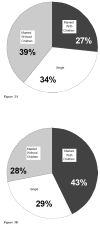The 88-hour family: effects of the 80-hour work week on marriage and childbirth in a surgical residency
- PMID: 17907445
- PMCID: PMC2150648
The 88-hour family: effects of the 80-hour work week on marriage and childbirth in a surgical residency
Abstract
The restriction of the resident physician work week to 80 hours has had dramatic affects on resident education and life-style. While effects on mood, psychological distress, and burn-out have been studied, the resultant changes in tangible quality of life have received little attention. Birth rate was considered a measurable, relevant outcome. The resident marital and parental status by duty month was collected from a single orthopaedic surgical residency program for the four academic years preceding and following the implementation of the 80-hour work week. The number of births to residents during these periods were also tallied. The relative prevalence of positive marital status changed very little between residents in the two time durations from 66 to 71 percent, but parental status increased from 27 to 43 percent. The number of births per married resident duty year also increased from 0.23 pre-restrictions to 0.32 post-restrictions. While the individual decisions involved in generating these observed changes are complex and difficult to entirely decipher, it is thought that an increased perception of life-control within the work-hour restrictions may have prompted the dramatic changes in birth rate among resident families.
Figures




Similar articles
-
Orthopaedic resident and program director opinions of resident duty hours: a national survey.J Bone Joint Surg Am. 2011 Dec 7;93(23):e1421-9. doi: 10.2106/JBJS.K.00700. J Bone Joint Surg Am. 2011. PMID: 22159864
-
The effect of work hour restrictions on the education of orthopaedic surgery residents.Clin Orthop Relat Res. 2006 Aug;449:128-33. doi: 10.1097/01.blo.0000224037.54345.77. Clin Orthop Relat Res. 2006. PMID: 16735877
-
Increased Academic Productivity of Orthopaedic Surgery Residents Following 2011 Duty Hour Reform.J Surg Educ. 2018 Jul-Aug;75(4):884-887. doi: 10.1016/j.jsurg.2017.12.001. Epub 2017 Dec 19. J Surg Educ. 2018. PMID: 29273338
-
The Impact of Duty Hour Restrictions on Orthopedic Surgical Training.Hand Clin. 2025 May;41(2):247-254. doi: 10.1016/j.hcl.2024.12.014. Epub 2025 Feb 22. Hand Clin. 2025. PMID: 40216516 Review.
-
The Interventional Arm of the Flexibility In Duty-Hour Requirements for Surgical Trainees Trial: First-Year Data Show Superior Quality In-Training Initiative Outcomes.J Surg Educ. 2016 Nov-Dec;73(6):e131-e135. doi: 10.1016/j.jsurg.2016.07.015. Epub 2016 Sep 16. J Surg Educ. 2016. PMID: 27651054 Review.
Cited by
-
Effects of the restriction of working time for residents: a dutch perspective.J Grad Med Educ. 2011 Dec;3(4):462-4. doi: 10.4300/JGME-D-11-00202.1. J Grad Med Educ. 2011. PMID: 23205191 Free PMC article. No abstract available.
-
Working conditions and trainee shortage in operative disciplines--is our profession ready for the next decade?Langenbecks Arch Surg. 2009 Jan;394(1):179-83. doi: 10.1007/s00423-008-0356-9. Epub 2008 Jun 25. Langenbecks Arch Surg. 2009. PMID: 18575884
-
Survey of the incidence and effect of major life events on graduate medical education trainees.Med Educ Online. 2015 Jun 11;20:27597. doi: 10.3402/meo.v20.27597. eCollection 2015. Med Educ Online. 2015. PMID: 26070948 Free PMC article.
-
Implementation of a resident night float system in a surgery department in Korea for 6 months: electronic medical record-based big data analysis and medical staff survey.Ann Surg Treat Res. 2019 May;96(5):209-215. doi: 10.4174/astr.2019.96.5.209. Epub 2019 Apr 24. Ann Surg Treat Res. 2019. PMID: 31073510 Free PMC article.
-
Does type of hospital ownership influence physicians' daily work schedules? An observational real-time study in German hospital departments.Hum Resour Health. 2009 May 27;7:41. doi: 10.1186/1478-4491-7-41. Hum Resour Health. 2009. PMID: 19473487 Free PMC article.
References
-
- Biller CK, Antonacci AC, Pelletier S, Homel P, Spann C, Cunningham MJ, Eavey RD. The 80-hour work guidelines and resident survey perceptions of quality. J Surg Res. 2006;135(2):275–81. - PubMed
-
- de Virgilio C, Yaghoubian A, Lewis RJ, Stabile BE, Putnam BA. The 80-hour resident workweek does not adversely affect patient outcomes or resident education. Curr Surg. 2006;63(6):435–9. discussion 440. - PubMed
-
- Schenarts PJ, Anderson Schenarts KD, Rotondo MF. Myths and realities of the 80-hour work week. Curr Surg. 2006;63(4):269–74. - PubMed
-
- Smith RW. Resident recruiting and the 80-hour week. Fam Med. 2005;37(1):9. - PubMed
MeSH terms
LinkOut - more resources
Full Text Sources
Medical
